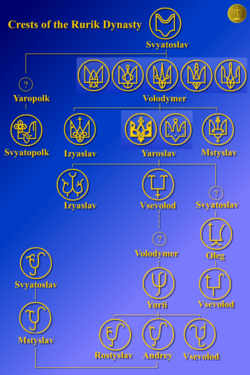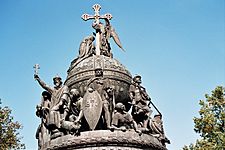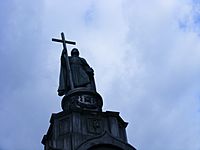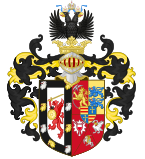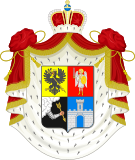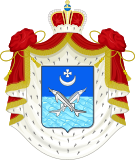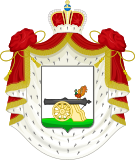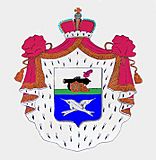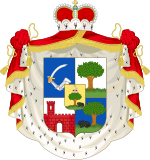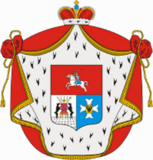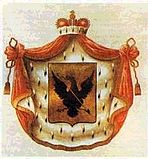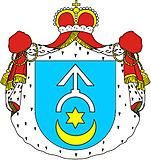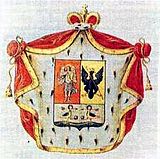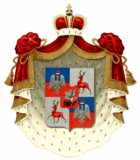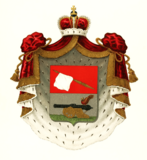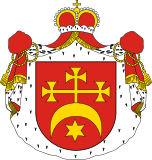Rurikids facts for kids
Quick facts for kids RurikidsRiurikids
Volodimerovichi |
|
|---|---|
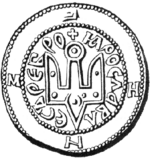
Personal seal of Yaroslav the Wise
|
|
| Country | |
| Founded | 862 (in Novgorod) |
| Founder | Rurik |
| Final ruler | Vasili IV of Russia |
| Titles |
Princely titles
|
| Style(s) | |
| Estate(s) |
|
| Deposition | 1610 (in Moscow, Tsardom of Russia |
| Cadet branches |
|
The Rurikids (also called Riurikids or Volodimerovichi) were a very old and powerful noble family. They are said to have been started by a prince named Rurik. He supposedly settled in Novgorod around the year 862 AD.
After Rurik's follower, Oleg the Wise, took over Kiev around 880, the Rurikids became the ruling family of a large state called Kievan Rus'. This state lasted for a long time. Over hundreds of years, the Rurikid family grew and split into many different branches. Each branch ruled different parts of the land. They continued to rule many of the smaller states that formed after Kievan Rus' broke apart.
Later, after the Mongol invasion, the western lands of Rus' came under the control of Poland and Lithuania. In the northwest, a new powerful state called the Grand Duchy of Moscow grew. It was ruled by descendants of Daniel of Moscow, who were also Rurikids. This Rurikid line ruled the Tsardom of Russia until 1598. After that, another family, the House of Romanov, took over in 1613. This period was known as the Time of Troubles.
The Rurikids ruled for over 700 years. This makes them one of Europe's oldest royal families. Many princely families today say they are descendants of Rurik.
Contents
Who Were the Rurikids?
The Start of the Dynasty
The exact beginnings of the Rurikid family are not fully clear. The story says that Rurik, a prince from a group called the Varangians, started the family in 862. This event is known as the "Calling of the Varangians". However, some modern experts think Rurik might be a legend, not a real person.
Early historical writings from Kiev, before the 1100s, did not mention Rurik. They usually traced the rulers back to Igor of Kiev. For example, a famous sermon from the 1050s praised Volodimer I of Kiev but only mentioned his father and grandfather.
It wasn't until the 1500s that church leaders in Rus' started saying that the ruling family of Moscow, called the Danilovichi, were part of a "Rurikid dynasty." They said this family went all the way back to the legendary Rurik. Because of these questions, some experts prefer to call the dynasty the Volodimerovichi. This name comes from Volodimer I of Kiev, who was definitely a real and important ruler.
Where Did the Rus' People Come From?
Most experts agree that the Rus' people came from what is now eastern Sweden. This was around the 700s. Their name might come from an old Norse word meaning "the men who row." Rowing was a main way to travel on the rivers of Eastern Europe.
The Primary Chronicle, an old historical record, tells a story about the "Calling of the Varangians" around 860-862 AD:
The people who used to pay tribute to the Varangians sent them away. They decided to rule themselves. But there was no order, and tribes started fighting each other. So they said, "Let's find a prince to rule us and judge us fairly." They went overseas to the Varangian Russes. These Varangians were called Russes, just like some are called Swedes or Normans. The Chuds, Slavs, Krivichians, and Ves' then told the Rus' people, "Our land is big and rich, but there is no order. Come and rule over us." So, three brothers and their relatives were chosen. They brought all the Russes with them and moved. The oldest, Rurik, settled in Novgorod. The second, Sineus, went to Beloozero. The third, Truvor, went to Izborsk. Because of these Varangians, the area around Novgorod became known as the land of Rus'. The people living in Novgorod now are from the Varangian group, but before, they were Slavs.
Even this old record has some confusing parts. However, things found by archaeologists, like old swords, show that there were Scandinavian people in the area by the 900s.
The Rurikid Story
Rurik and his brothers are said to have started the state that historians now call Kievan Rus'. By the mid-1100s, Kievan Rus' had split into many independent principalities (smaller states). Each was ruled by a different branch of the Rurikid family.
The family followed a rule where the oldest male relative inherited the throne. After the death of Yaroslav the Wise in 1054, the family split into three main branches. These branches came from Yaroslav's three sons: Iziaslav, Sviatoslav, and Vsevolod.
Later, a meeting called the Council of Liubech changed the rules for who could rule. It divided the land into several self-governing areas. Each of these areas had a right to try and get the main throne in Kiev.
Vsevolod's family line became the most important. They were known as the Monomakhovichi. Sviatoslav's line, called the Olegovychi, often claimed lands in Chernihiv.
According to historian Jaroslav Pelenski, the Rurikid family tried to unite their diverse lands under the idea of "the Rus' land" and a "Rus' people." But Kievan Rus' was never truly united. It was a loose group of lands and cities. People living there were loyal to their local areas, not always to a central ruler.
This led to the Rurikid family breaking into several sub-dynasties (smaller ruling families) in the 900s and 1000s. These included the Olgoviches in Chernigov, the Yuryeviches in Vladimir-Suzdal, and the Romanoviches in Galicia-Volhynia.
Descendants of Sviatoslav II
The Olgoviches were descendants of Oleg I of Chernigov. He was a son of Sviatoslav II of Kiev. They ruled until the early 1300s. Then, the growing Grand Duchy of Lithuania and Grand Duchy of Moscow took over their lands. Some modern families like the Massalsky, Gorchakov, Baryatinsky, Volkonsky, and Obolensky come from this line.
Descendants of Vsevolod I
Vsevolod I of Kiev was the father of Vladimir II Monomakh. This is where the name Monomakh comes from for his descendants. Two of Vladimir II's sons were Mstislav I of Kiev and Yuri Dolgorukiy.
The Romanoviches were the family line of Roman the Great. They came from Mstislav I of Kiev. This line ruled the Principality of Volhynia and later became kings of Galicia and Volhynia. They ruled until 1323. The last two Romanovychi brothers, Andrew and Lev II, ruled together. They were killed trying to stop attacks from the Mongols.
Even after losing their main power, the Rurikids were still important in the Grand Duchy of Lithuania and later in the Polish–Lithuanian Commonwealth. For example, the Ostrogski family worked to keep the Ruthenian language and the Eastern Orthodox religion alive.
The Rostislaviches were the line of Rostislav I of Kiev, another son of Mstislav I. He was the Prince of Smolensk. Many families today come from the princes of Smolensk and Yaroslavl.
The Shakhovskoys family started with Konstantin "Shakh" Glebovich. He was a Prince of Yaroslavl. This family is thought to be the oldest existing branch of the Rurikids. Many Shakhovskoys live outside Russia today, having left during the Russian Revolution.
The Yuryeviches family was started by Yuriy Dolgorukiy. He founded the city of Moscow. His son, Vsevolod the Big Nest, was the Prince of Vladimir-Suzdal. This state was an early version of the Grand Principality of Moscow and later the Russian Empire. Vsevolod's son Konstantin of Rostov was the Prince of Rostov. Another son, Ivan Vsevolodich, was the Prince of Starodub. Many families today, like the Gagarin line, come from him.
Vsevolod's son Yaroslav II of Vladimir was the father of Alexander Nevsky. Alexander Nevsky's son, Daniel of Moscow, started the ruling family of Moscow. This family ruled until the end of the 1500s.
The Muscovite branch of the Rurikids began using the title "Tsar of All Russia" with Ivan the Terrible. The Rurikid dynasty ended when Tsar Feodor I died in 1598. The period after his death was very unstable and was called the Time of Troubles. It lasted until 1613.
In 1613, Mikhail I became Tsar, starting the Romanov dynasty. This family ruled until 1917. Mikhail's father was related to the Rurikid dynasty through his mother. Later, Emperor Peter III and his wife Catherine the Great also had Rurikid ancestors.
Rurikid Family Branches
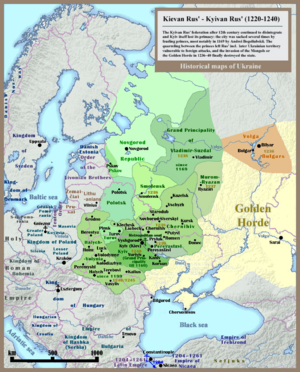
Here are some of the main branches of the Rurikid family:
- Volodimerovichi, who were the grand princes of Kiev.
- Izyaslavichi of Polotsk, princes of Polotsk.
- Putyatin, who are still around today.
- Izyaslavichi of Turov, princes of Turiv and Volhynia.
- Izyaslavichi of Polotsk, princes of Polotsk.
- Monomakhovichi, princes of Pereyaslav.
- Izyaslavichi of Volhynia, princes of Volhynia, kings of Rus' (the senior branch).
- Rostislavichi of Smolensk, princes of Smolensk (a middle branch).
- Kropotkin, who are still around today.
- Lvov princely family, who appeared in the 1600s.
- Rzhesvsky, who are still around today.
- Prozorovsky (this line ended in 1914).
- Yurievichi, princes of Vladimir-Suzdal.
- Daniilovichi, princes of Moscow. This branch ruled in Muscovy and the Tsardom of Russia until it ended in 1598 with the death of Feodor I. This led to the Time of Troubles.
- Konstantinovichi, princes of Galich, Russia.
- Lyapunov family, who appeared in the 1500s.
- Shakhovskoy, princes of Yaroslavl (the oldest existing branch).
- Lobanov-Rostovsky, princes of Rostov (a middle existing branch).
- Gagarin, princes of Starodub-on-the-Klyazma (a younger existing branch).
- Khilkov, princes of Starodub-on-the-Klyazma (a younger existing branch).
- Sviatoslavichi, princes of Ryazan and Murom.
- Olgovichi, princes of Chernihiv.
- Gorchakov, who are still around today.
- Massalski family, princes of Mosalsky.
- Obolensky, who are still around today.
- Dolgorukov, who are a branch of the Obolensky family and still exist.
- Olgovichi, princes of Chernihiv.
- Rostislavichi of Tmutarakan, princes of Tmutarakan.
- Rostislavichi of Halych, princes of Halych.
- Vadbosky, a branch of the princes Belozersky (still existing).
- Volkonsky, a branch of the princes of Tarusa (still existing).
Disputed Branches
Some families might be Rurikids, but it's not fully proven:
- The Ogiński family.
- The Ostrogski family.
- The Wiśniowiecki family.
Rurikid Legacy
Historians from Russia and Ukraine have long discussed the importance of the Rurikid dynasty. The Russian view sees the Grand Duchy of Moscow as the main successor to Kievan Rus'. This is because Russia was ruled by Rurikids until the 1500s. The Ukrainian view, which developed later, sees the Ukrainian descendants of the Rurikids as the true successors.
Today, several branches of the Rurikids still exist. These include the Houses of Shakhovskoy, Gagarin, and Lobanov-Rostovsky. For example, Prince Dmitriy Mikhailovich Shakhovskoy (born 1934), Prince Dmitri Andreevich Gagarin (born 1973), and Prince Nikita Lobanov-Rostovsky (born 1935) are all living descendants. They all belong to the Monomakhovichi branch. The Shakhovskoys claim to be the most senior line.
Gallery
-
Arms of the House of Holstein-Gottorp-Romanov
-
Coat of arms of the families of Monastyrev stock is composed of Smolensk and Belozersk emblems.
-
The Obolensky – Repnin coat of arms is composed of the emblems of Kyiv and Chernigov.
-
Coat of arms of the Tatischev family
See Also
 In Spanish: Rúrikovich para niños
In Spanish: Rúrikovich para niños
- Grand Prince of Kiev
- Shum-gora
- Prince of Tver
- Knyaz
- Symbols of the Rurikids


